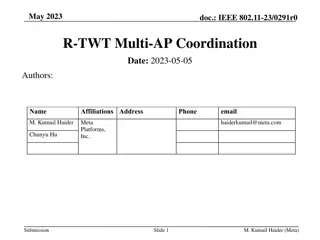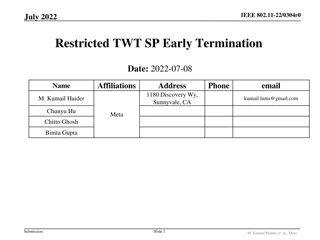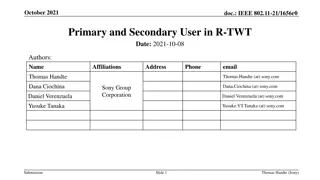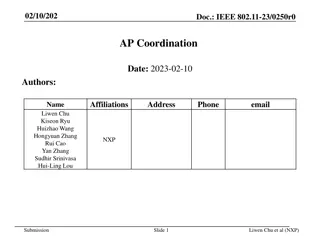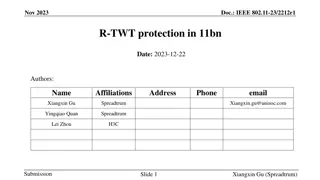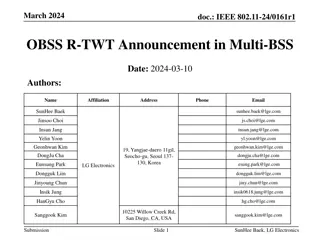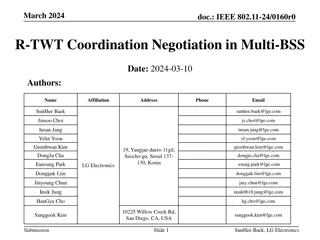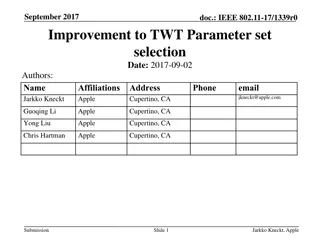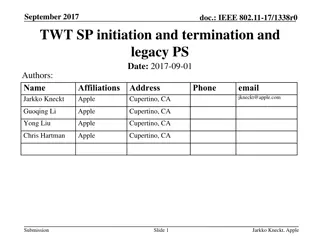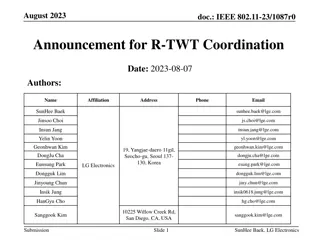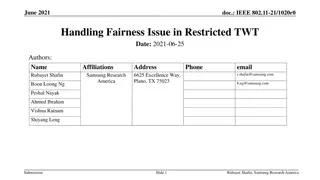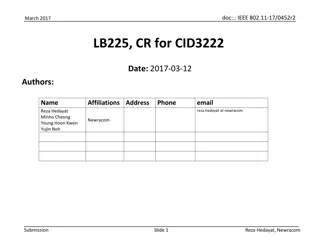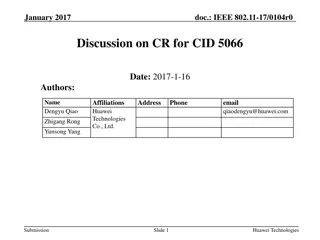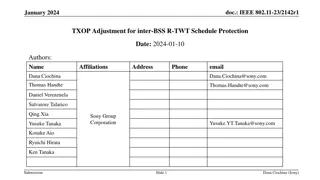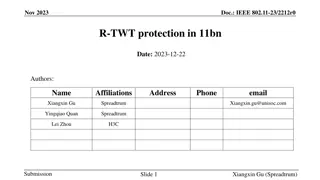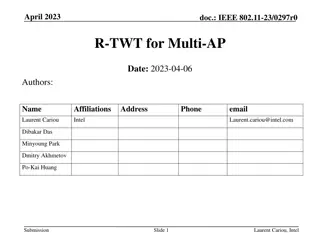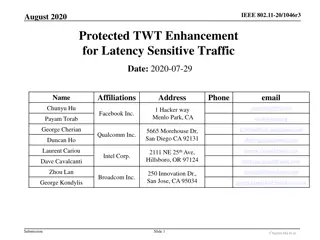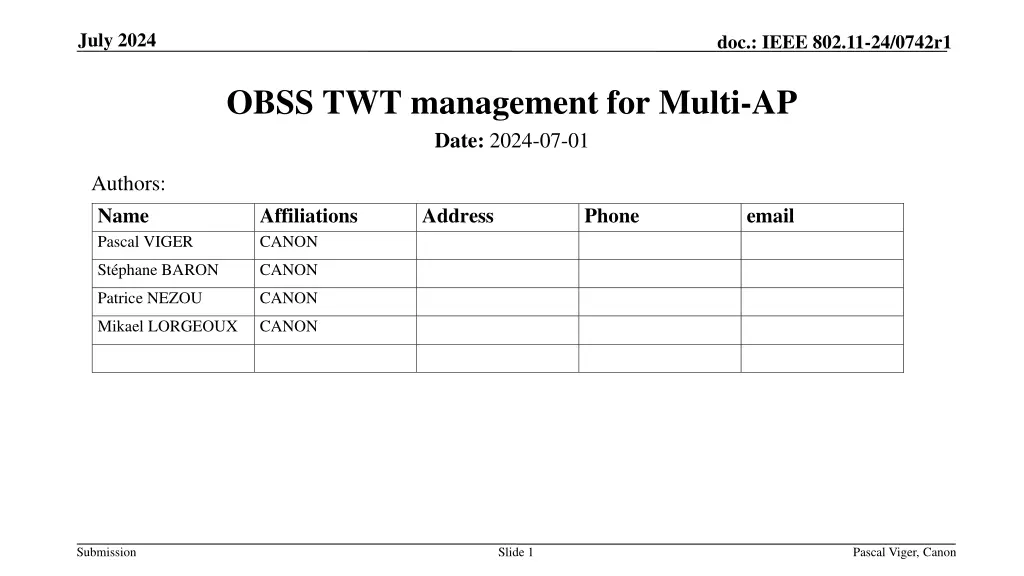
IEEE 802.11bn Multi-AP Coordination: TWT Management Overview
Explore the IEEE 802.11-24/0742r1 document discussing Coordinated TWT principles for Multi-AP coordination in 802.11bn networks. Learn about OBSS TWT, medium access functionalities, and SP alignment strategies outlined for improved network efficiency.
Download Presentation

Please find below an Image/Link to download the presentation.
The content on the website is provided AS IS for your information and personal use only. It may not be sold, licensed, or shared on other websites without obtaining consent from the author. If you encounter any issues during the download, it is possible that the publisher has removed the file from their server.
You are allowed to download the files provided on this website for personal or commercial use, subject to the condition that they are used lawfully. All files are the property of their respective owners.
The content on the website is provided AS IS for your information and personal use only. It may not be sold, licensed, or shared on other websites without obtaining consent from the author.
E N D
Presentation Transcript
July 2024 doc.: IEEE 802.11-24/0742r1 OBSS TWT management for Multi-AP Date: 2024-07-01 Authors: Name Pascal VIGER Affiliations CANON Address Phone email St phane BARON CANON Patrice NEZOU CANON Mikael LORGEOUX CANON Submission Slide 1 Pascal Viger, Canon
July 2024 doc.: IEEE 802.11-24/0742r1 Abstract In this contribution, we highlight some medium access functionalities during an R-TWT SP for multi-AP coordination in 802.11bn Submission Slide 2 Pascal Viger, Canon
July 2024 doc.: IEEE 802.11-24/0742r1 Introduction Multi-AP (MAP) Coordination is one of the key features considered for IEEE 802.11bn. By coordinating among overlapping BSSs, MAP coordination technology promises better network efficiency. Coordinated (R-)TWT is seen as one of the most promising scheme for MAP coordination. Submission Slide 3 Pascal Viger, Canon
July 2024 doc.: IEEE 802.11-24/0742r1 Coordinated TWT principle Many contributions (e.g. [2][3][4]) presented Coordinated SPs of an OBSS schedule, based on R-TWT: Coordinated Medium Access allows several APs to coordinate their medium access to provide enhanced latency sensitive traffic delivery [2] An AP can announce whether it respects the R-TWT SPs of its neighbor AP, and indicate that the associated R-TWT STAs need to respect neighbor AP R-TWT SPs [3] AP and STAs will stop the TXOP at the beginning of an neighbor AP TWT SP [2][3][4] The term OBSS TWT designates replication of a (neighbor) first BSS TWT in a second BSS. Following slides will provide possible STA operations to reduce OBSS interferences during an OBSS TWT SP. Slide 4 Submission Pascal Viger, Canon
July 2024 doc.: IEEE 802.11-24/0742r1 Medium access during OBSS TWT SP (*: timely aligned means SP starting times are fully aligned in time) An AP2 (see next slide) sends to its STAs an OBSS TWT element defining (second) TWT SPs timely aligned* with (first) TWT SPs of a first AP1, such that it can adjust the communication policy of its own STAs: Option 1: OBSS TWT element forbids the stations of the AP2 BSS to access the medium during the second TWT SPs Option 2: OBSS TWT element defines a waiting time for the stations of AP2 BSS to access the medium that is larger than a waiting time for stations of AP1 BSS to access the medium during the first TWT SPs. Typically, STAs perform a CCA (channel sensing) during a larger time. e.g. degraded AIFSN value may be set by the second AP to a Minimum TWT Wake Duration negotiated with the first AP Option 3: OBSS TWT element indicates a temporary operating channel for stations of AP2 BSS to switch to for their communication during the second TWT SP E.g. Channel Switch Announcement, DSO, Secondary Channel Access , Submission Slide 5 Pascal Viger, Canon
July 2024 doc.: IEEE 802.11-24/0742r1 Illustration of options 1 and 2 option 1 option 2 Option 1: access forbidden very low risks of interference to the detriment of communication efficiency in the AP2 BSS Option 2: waiting time stations not interfering with the AP1 BSS are not subject to OBSS limitation R-TWT SP R-TWT SP MAP Req AP1 beacon Beacon beacon Beacon First BSS STA11 Access forbidden MAP Resp AP2 beacon Beacon Probe Resp Second Waiting time STA21 BSS STA22 OBSS TWT IE OBSS TWT IE OBSS TWT SP OBSS TWT SP Sensing period Submission Slide 6 Pascal Viger, Canon
July 2024 doc.: IEEE 802.11-24/0742r1 Summary To reduce OBSS interference among a Multiple AP set, we introduced concepts and solutions for reduced communication activities for stations of neighbouring BSS during the coordinated R-TWT (OBSS TWT) SPs. Three modes/options of operation are identified (forbids STAs to access, waiting time to access, channel switch). Next steps: provide simulation results about the various options Submission Slide 7 Pascal Viger, Canon
July 2024 doc.: IEEE 802.11-24/0742r1 Straw Poll Do you agree to add to the TGbn SFD the following ? define mechanisms that enable APs of a Multi-AP set to modify their STAs medium access policy during coordinated R-TWT (aka OBSS TWT) schedule(s) - objective is to reduce interferences encountered by one BSS of the MAP set during the scheduled period; - detailed mechanisms are TBD. Submission Slide 8 Pascal Viger, Canon
July 2024 doc.: IEEE 802.11-24/0742r1 References [1] 802.11bn PAR [2] 11-23/226 Considerations for AP coordination in UHR: Coordinated Medium Access, Abdel Ajami (Qualcomm) [3] 11-23/250 AP Coordination, Liwen Chu (NXP) [4] 11-23/291 R-TWT Multi-AP Coordination, Kumail Haider (Meta) Submission Slide 9 Pascal Viger, Canon


